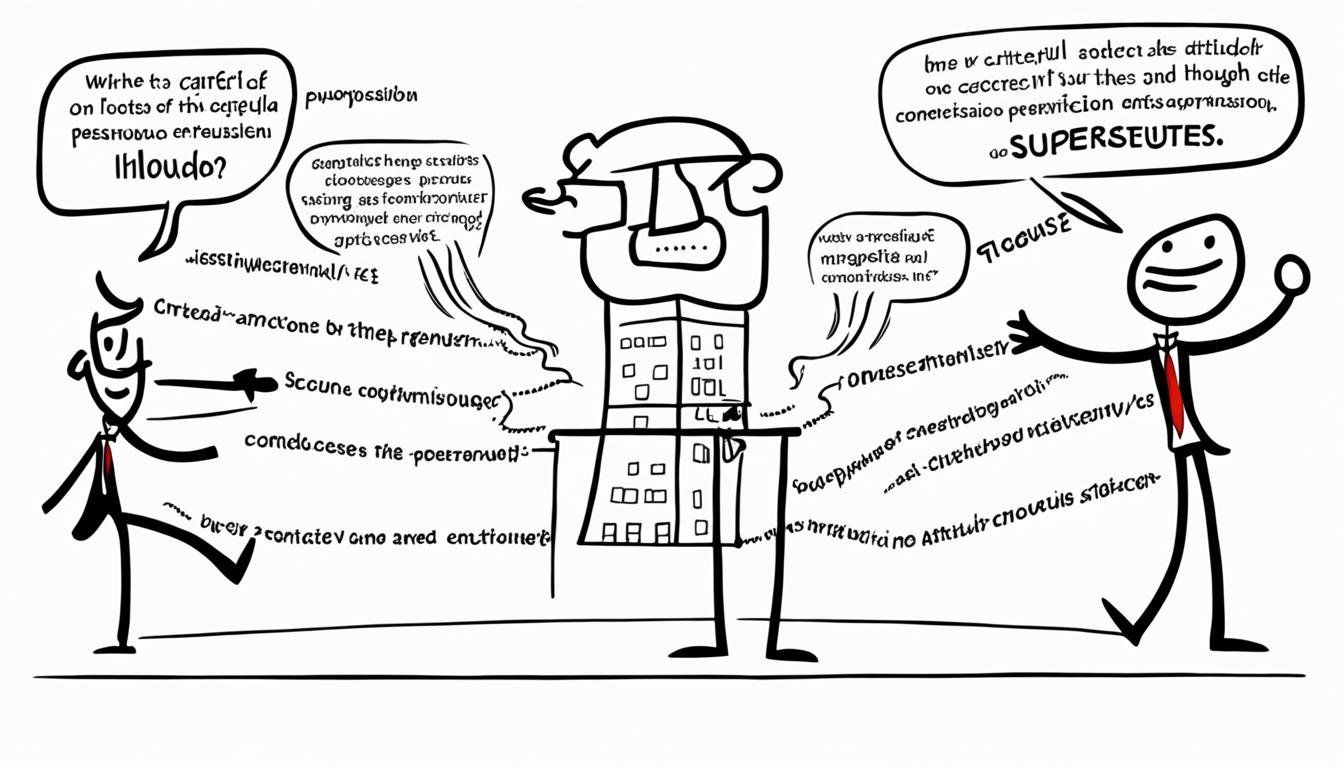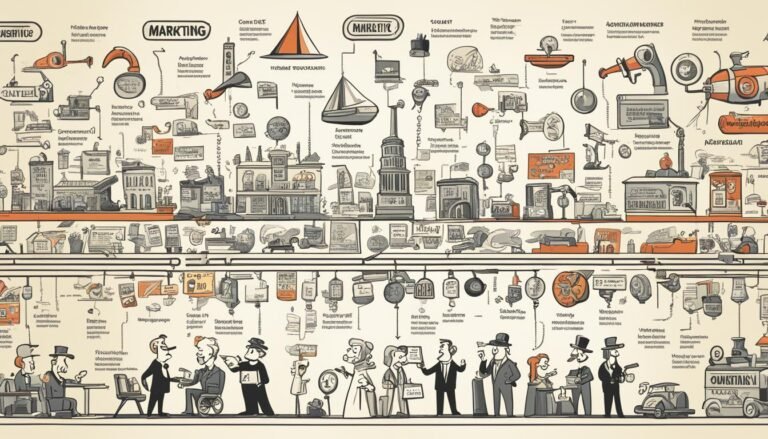The Elaboration Likelihood Model: Persuasion and Attitude Change
Did you know the Elaboration Likelihood Model (ELM) was first studied in the 1940s and ’80s? Richard E. Petty and John T. Cacioppo, psychologists, created this theory. It shows how we process persuasive messages through two main ways: the central and peripheral routes.
This study found that how we change our attitudes depends on our motivation and ability to think deeply about the message. The ELM is based on the Dual Processing Theory. It says that when we think deeply about a message, we change our attitudes more deeply.
On the other hand, if we don’t think much about it, we might just follow what looks good or feels right. This can lead to quick changes in attitude but they might not last.
Key Takeaways
- The Elaboration Likelihood Model (ELM) categorizes attitude change through central and peripheral routes.
- Higher levels of elaboration lead to the central route, involving analytical processing of information.
- Lower levels of elaboration lead to the peripheral route, where superficial cues drive persuasion.
- Credibility, physical attractiveness, and expertise of the source significantly impact persuasion.
- The effectiveness of persuasion via the central route leads to more lasting attitude changes.
- Peripheral route processing typically results in temporary attitude changes influenced by emotional and indirect cues.
Introduction to the Elaboration Likelihood Model
The Elaboration Likelihood Model (ELM) is key to understanding persuasive communication and its impact on attitude shifts. Richard E. Petty and John T. Cacioppo created it in the early 1980s. It shows how people process persuasive messages and their cognitive processing. This model is vital for marketers, educators, and anyone wanting to change opinions and behaviors.
Origins of the ELM
The origin of ELM goes back to when Petty and Cacioppo aimed to explain how deeply people think about persuasive messages. This was during a time when changing attitudes and consistent behavior were big topics in psychology. Petty & Cacioppo (1986) laid out seven main points that describe these processes.
Key Concepts and Definitions
The ELM talks about two ways to persuade people: the central route and the peripheral route. The central route means deep cognitive processing, where people really think about the arguments, leading to lasting attitude shifts. The peripheral route is about quick, shallow thinking, using things like the speaker’s looks or other easy-to-spot message parts.
Studies show that people’s differences matter. For example, those who often watch themselves in social situations are more likely to be swayed by ads that talk about social image. Those who don’t often think about how they appear to others focus more on what the product can do. Knowing this helps make persuasive communication that works well with different people.
Central Route to Persuasion
The Central Route to Persuasion is a key idea in the Elaboration Likelihood Model (ELM) by Petty and Cacioppo in 1986. It shows how deep thinking about a message’s content leads to lasting attitude changes. We’ll look into what makes this route work.
Characteristics of Central Route Processing
Central route processing means putting a lot of thought into the message. People who use this method want to understand the info well and can do so. Important traits include:
- Persuasive Communication: Messages need to be clear and logical to persuade through the central route.
- Motivation to Process: People must want to look into the content, often because it matters to them or they’re interested.
- Ability to Process: The audience needs to be able to understand and check the arguments given.
- Strong Arguments: Messages must have facts and logical arguments that can stand up to questioning for lasting effects.
Effectiveness of Central Route on Attitude Change
Using the central route often leads to lasting changes in attitudes. This method takes a lot of thinking, as people look into and judge the logic of the arguments. The main benefits are:
- Temporal Persistence: Changes in attitudes through central route persuasion last longer.
- Resistance to Counterarguments: Strong arguments are better at fighting off other views.
- High Involvement Processing: This persuasion makes people more engaged, leading to a deeper understanding and bigger impact.
In summary, the central route’s focus on logic, detailed argument checking, and a lot of thinking leads to lasting and strong attitude changes.
Peripheral Route to Persuasion
In psychology, the Elaboration Likelihood Model (ELM) talks about two ways to persuade people. The Peripheral Route to Persuasion is a quick way that doesn’t need much thought. It uses things like how good-looking the speaker is, how emotional the message is, or how often it’s repeated to make people quickly agree or disagree.
People often save their brain power for important tasks. When persuaded by looks or feelings, the change in opinion is usually short-lived and easy to change back. Studies show that if a source is trusted and liked, it can change opinions without needing deep thought (Hovland & Weiss, 1951; Eagly & Chaiken, 1975).
The central route needs careful thought and checking of the message’s arguments. The peripheral route uses superficial cues. This quick way of thinking often leads to fast but weak changes in opinion. Research by Petty & Cacioppo (1984) found that soft messages work better, and products in TV shows or movies use this to get noticed (Gupta & Lord, 1998).
Pay attention is key in the Peripheral Route to Persuasion (Albarracín & Wyer, 2001; Festinger & Maccoby, 1964). When people are in a hurry or their brains are full, they use shortcuts. This way, they don’t use too much brain power and can make quick decisions based on simple rules.
To sum up, the central route to persuasion is about thinking deeply and carefully. The Peripheral Route to Persuasion uses easy shortcuts and looks, leading to quick but not lasting changes in opinion. This idea helps marketers and communicators know how to reach people in different ways.
Factors Influencing Elaboration
The Elaboration Likelihood Model (ELM), created by Richard E. Petty and John Cacioppo in 1986, helps us understand how we process persuasive messages. It focuses on motivation and ability as key factors in message processing.
Motivation
Persuasion motivation is crucial for how much we elaborate on a message. Things like how relevant the issue is, enjoying thinking deeply, and feeling responsible to understand the message can motivate us. When we’re highly motivated, we dive deep into the message, checking out the arguments and evidence closely.
This deep thinking can lead to lasting changes in our attitudes, which is what marketers and advertisers aim for.
Ability
Our ability to think more about a message depends on several things. Our cognitive resources, like our brain power and what we already know, are very important. Also, having enough time to think and not being distracted helps a lot.
If we have strong thinking skills and a good environment for thinking, we’re more likely to deeply consider the message. But if our thinking abilities are weak or we’re distracted, we might just focus on the speaker’s looks or trustworthiness. This can lead to quick changes in attitude but not lasting ones.
Knowing about these factors of elaboration helps us make better persuasive messages. By making the audience more motivated and able to think deeply, we can bring about lasting attitude changes. This uses the Elaboration Likelihood Model effectively.
The Role of Source Credibility
Source credibility is key in persuasion. It includes expertise impact and trustworthiness. How people see the source’s reliability and authority is crucial. This makes it vital for changing attitudes and effective communication.
Impact of Expertise and Trustworthiness
A source’s knowledge and trustworthiness greatly affect persuasion. Research shows that experts are often seen as more credible. This boosts the persuasive appeal of what they say. Trustworthiness makes people more likely to accept information.
Other things like the message’s complexity, how the audience feels, and the setting can change this effect.
Examples of Source Credibility in Practice
Source credibility is used in many areas. In marketing, using famous people can make a product more credible. For instance, Nike works with athletes to boost their product’s credibility through the athletes’ sports expertise.
Public health messages often use doctors to make them more persuasive. A great example is Dr. Anthony Fauci promoting COVID-19 vaccines. His trustworthiness helped make the message more accepted.
Message Quality and Its Influence
In the world of persuasive messaging, the quality of the message matters a lot. The strength of the arguments greatly affects how well the message persuades, especially through the Elaboration Likelihood Model (ELM). Strong arguments make it more likely that the audience’s attitudes will change for the better.
Importance of Strong Arguments
Strong arguments are key to effective persuasive messages. The Journal of Verbal Learning and Verbal Behavior (1982) found that logical, coherent arguments with solid evidence get better cognitive responses. These responses often lead to deeper and lasting attitude changes in people. A thorough argument strength assessment makes sure the main points are well-supported, making the message stronger and more relatable.
Strong arguments, presented clearly, can use the power of message quality to persuade people well. The Journal of Experimental Social Psychology (1977) showed that people tend to agree with messages that have a lot of evidence and logical thinking.
Identifying Weak Arguments
On the other hand, weak arguments can hurt the effectiveness of persuasive messages. Arguments without support, or those that don’t connect with the audience, often get rejected. Research in the Public Opinion Quarterly (1978) found that such arguments lead to skepticism and might even cause people to argue against the message.
Good communicators need to be good at checking the strength of arguments to get rid of the weak ones. This process refines the message, making sure only strong and persuasive parts are shared. A study in the Psychological Bulletin (1977) showed that knowing the difference between strong and weak arguments is key to making messages that stand up to scrutiny and connect with people.
In summary, the message quality is closely tied to the strength of the arguments. By focusing on strong arguments and cutting out the weak ones, communicators can make messages that are not just persuasive but also lasting, leading to positive attitude changes that last.
The Effect of Cognitive Elaboration on Persuasion
The Elaboration Likelihood Model (ELM) shows how thinking deeply about messages matters in persuasion. It talks about two ways people process persuasive messages: objectively or with bias.
Objective vs. Biased Elaboration
Objective analysis means looking at a message without bias, trying to understand it fully before making a decision. This approach aims to see the message’s strengths fairly. On the other hand, biased processing lets past experiences, feelings, or beliefs shape how we see the message.
Richard E. Petty and John Cacioppo introduced the ELM in the 1980s. They found that how much people think about a message and why they care about it affects how they process it. This can lead to different outcomes in persuasion.
Case Studies of Cognitive Elaboration
Studies show that deep thinking about messages can change attitudes. For example, when people really care about a message, they tend to think about it objectively. This leads to lasting attitude changes. But, if people are swayed by their feelings or past experiences, their attitudes might not last.
Research also looks at how being around others affects how we think about messages. For instance, hearing from multiple sources can change how we process information. These findings highlight the complex ways persuasion works.
The ELM helps us understand how our thoughts and feelings mix with messages to shape our attitudes and choices. It shows the importance of both objective and biased thinking in persuasion.
Motivation and Its Role in the ELM
In the Elaboration Likelihood Model (ELM), motivation is key to how people process messages deeply. It helps decide if someone will look closely at the message or just glance over it.
When people are really motivated, they dive deep into the arguments given. This leads to lasting changes in their views. Motivation makes them analyze and think over the message more.
Studies reveal that things like risk, how familiar someone is with a task, and their negotiation skills boost motivation. This makes them better at understanding the message deeply.
Auditors often let client cooperation influence their decisions, especially if they’re not very motivated. This shows why boosting motivation is crucial. But, it’s not enough to fight off the impact of mood on decisions.
Even motivated auditors can be swayed by past client behavior. This shows they often lean towards what the client wants. So, we need strategies that boost motivation and tackle biases too.
The ELM works best when motivation meets enough thinking power. As motivation grows, so does the ability to change attitudes deeply by evaluating messages well.
In summary, a strong motivational drive is vital in the ELM. It leads people to think deeply and change their views for the long term.
How Distraction Affects Message Processing
Distraction is key in how we take in persuasive messages. It pulls our focus away, making us lean on what’s around us more. This shift is important to grasp the distraction’s impact on persuasion. It happens when we can’t fully think over messages because of distractions around us.
Peripheral Cues and Distraction
With distractions, we often use what’s on the edge of our vision to get information. This happens because we’re not fully focused on the main message. So, things like how good-looking the speaker is or other surface-level details can affect us more. Studies show distractions change how persuasion works, putting more emphasis on peripheral cues reliance.
Knowing how we process these cues when distracted helps us make better messages. This is really important in ads and marketing. They use things like catchy tunes or pretty pictures to grab our attention despite environmental distractions.
Environmental Factors
Things like loud noises, doing multiple tasks at once, and other distractions make it hard to deeply understand messages. We start to pay more attention to what’s easy to notice. For instance, someone trying to listen to a message in a loud place will likely focus more on what feels right than the actual words.
So, when we want to persuade someone, we need to think about how distraction affects persuasion. We can try to reduce distractions or make messages that use easy-to-spot cues. This way, our messages can still work well, even when things are not perfect.
The Elaboration Likelihood Model: Persuasion and Attitude Change
The Elaboration Likelihood Model (ELM) is key in understanding persuasion and attitude change. It shows how deep or shallow thinking affects how messages influence us. In marketing and advertising, the ELM helps shape strategies to change consumer behavior.
Applications in Marketing and Advertising
Marketing uses the ELM to choose between deep or superficial processing. For motivated, capable consumers, deep processing is best. Ads with detailed info, logical arguments, and strong evidence work well here.
For less motivated audiences, marketing turns to peripheral cues like celebrity endorsements and catchy slogans. These grab attention and change attitudes through simpler processing. The success of ads depends on matching the message with how much people can and want to think about it.
Real-World Examples
Many brands have successfully used the ELM in their ads. Amazon, for example, targets different customers with both deep and shallow messages. They offer detailed product info and customer reviews for those who like to think deeply, building positive attitudes.
Amazon also uses “Deal of the Day” and eye-catching banners to attract those who don’t want to think too much. These real-world persuasion examples show the value of using both deep and shallow messages in ads.
The Elaboration Likelihood Model gives marketers a powerful way to create messages that change attitudes deeply and lastingly.
Conclusion
The Elaboration Likelihood Model (ELM) was created by John Cacioppo and Richard Petty in the 1970s. It helps us understand how persuasion and attitude change work. It shows us the importance of thinking deeply about messages and the factors that affect how persuasive they are.
The ELM talks about two main ways people can be persuaded: the central and peripheral routes. The central route happens when people really think about a message and its details. This can lead to lasting changes in behavior.
The peripheral route is different. It happens when people don’t think too much about a message but are swayed by things like ads or catchy slogans. This can lead to quick changes in attitude but may not last long.
How people process messages depends on their motivation and ability. The ELM says that if someone is motivated and can understand a message well, they’ll likely think deeply about it. This can make their attitude change more lasting.
The ELM has big implications, especially for marketing and advertising. Knowing how to persuade people can make campaigns more effective. By making messages appealing to both deep thinkers and quick scanners, marketers can reach more people and make a bigger impact.
This model helps us understand how attitudes form, get stronger, or change. It’s useful for both studying persuasion and making it work in real life.
Source Links
- The Elaboration Likelihood Model of Persuasion
- What Is the Elaboration Likelihood Model in Psychology?
- Routes of Persuasion
- Elaboration Likelihood Model of Persuasion
- The Elaboration Likelihood Model of Persuasion Explained
- Elaboration likelihood model
- Central Route to Persuasion: Definition & Examples
- Routes of Persuasion
- Routes of Persuasion: Central and Peripheral Routes – Concept | Social Psychology | JoVe
- Central vs Peripheral Routes of Persuasion: understanding the elaboration likelihood model
- How the elaboration likelihood model can persuade an audience
- The Effects of Source Credibility in the Presence or Absence of Prior Attitudes: Implications for the Design of Persuasive Communication Campaigns
- The Elaboration Likelihood Model of Persuasion
- Elaboration Likelihood Model
- [PDF] The Elaboration Likelihood Model of Persuasion | Semantic Scholar
- Elaboration Likelihood Model of Persuasion Explained – SM Insight
- No title found
- The Elaboration Likelihood Model: A Meta-Theory for Synthesizing Auditor Judgment and Decision-Making Research
- Elaboration Likelihood Model – Persuasion Context
- c05.indd
- Elaboration Likelihood Model
- Persuasion: Applying the Elaboration Likelihood Model to Design
- Persuasion, attitude change, and the elaboration likelihood model… | Channels for Pearson+
- Elaboration Likelihood Model Theory: How to Use ELM
- 11.3 Attitudes & Persuasion
- How leaders are persuaded: An elaboration likelihood model of voice endorsement







